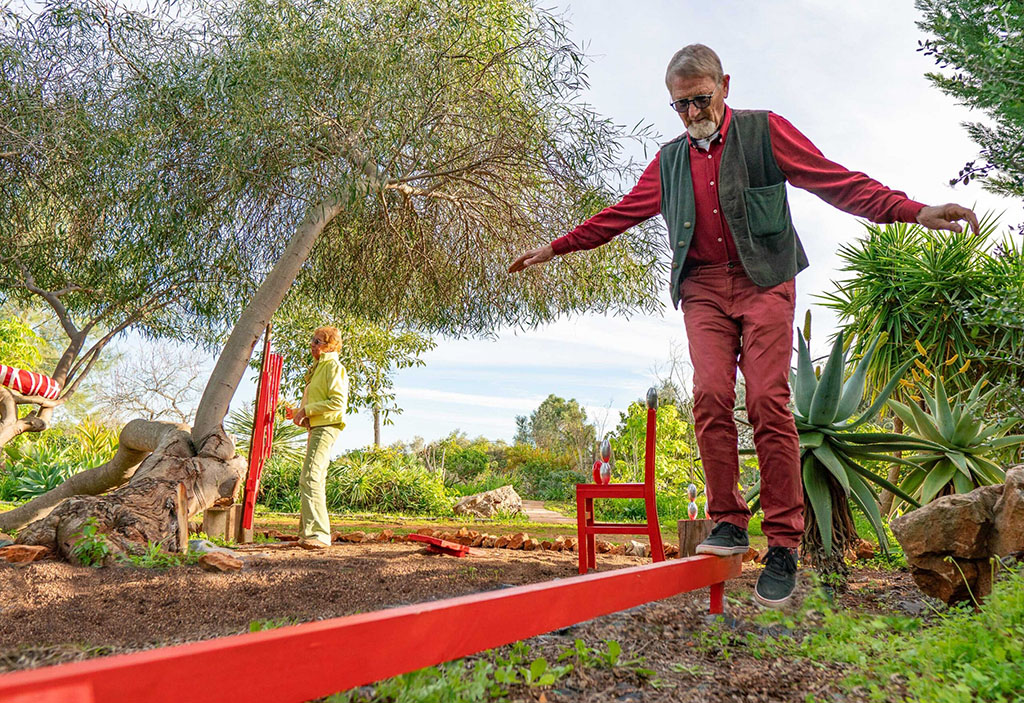A couple of intrepid Algarve residents, Gudrun and Gerhard Witt, have invented a “balance garden”
In life, we all need balance. There are many different kinds of balance. Every time you stand or walk, you are exhibiting balance. Most mammals walk on four legs. It’s much easier to remain upright on four legs than on two.
When was the last time you heard of a dog getting hurt just because she or he fell over? I’ve seen three-legged dogs walk pretty well, but two legs aren’t enough for a dog, unless he or she is in a circus act. But this article is actually about balance for people.

Our ability to balance on two legs is quite amazing, if not miraculous. The chief organ of balance (the vestibular system) is found inside the inner ear. It is continually sending signals to the cerebellum, which is in the back of the brain. This system is made up of three semicircular canals and two otolith organs, known as the utricle and the saccule.
The semicircular canals and the otolith organs are filled with fluid. The fluid moves around and constantly tells you which end is up. The brain also receives visual and other sensory cues to tell the rest of your body how to balance. In short, we are all bipedal miracles.

A couple of intrepid Algarve residents, Gudrun and Gerhard Witt, have invented a “balance garden” on a small part of their lovely rustic property. They created it for enjoyment and exercise, and also to improve their balance. They quickly dispelled my suggestion that “hey, that’s great for seniors”, saying, “It’s good for young people too!”
Gudrun and Gerhard were only too happy to demonstrate the various exercises in the balance garden. In fact, it seems impossible not to be happy while doing so. There is a thin long plank to walk, a mini rocking see-saw, a side-to-side swinging platform, a hanging bridge, small tree stumps, stilts, bamboo poles, and other assorted items to balance with.

All the stations are painted a cheerful, unifying red. As Gudrun and Gerhard’s bodies got a good workout, perhaps their smile muscles were the most used. The activity became infectious, and we all had a really good time balancing. One caution; it’s not as easy as it looks. You might think your balance is good, but the Witts’ balance garden might show you that you have room for improvement.
Here’s a test that many medical professionals recommend: stand on one leg with your other leg pressed against it, arms by your sides, eyes fixed straight ahead, and try to hold the position for 10 seconds. I couldn’t do it at first, but with some practice, I improved.
After my visit to the Witts’ balance garden, I started to feel an improvement. I can testify that I immediately felt elated by its effects, and I would call it a “balance high”.
Perhaps some good endorphins are released to create the balance high. I’m not a bio-science major, but I know this is a good thing.
Gudrun and Gerhard have created something of tangible value in their garden. They care for many beautiful plants and trees as well, and it’s a lovely place to be. Besides their health-centered approach to balance, the Witts are also philosophical about balance. As an example, they mention the benefits of balance between work and leisure.
We all hear about eating a balanced diet. We have many parts of our mind and
body to use and exercise, and that’s all about balance. In fact, it’s indisputable that a successful life is one big balancing act.
By ERIC ROTH
|| features@portugalresident.com
Eric Roth is a lifelong photojournalist who has recently emigrated from Boston, USA to the Algarve. He loves nature and wildlife. 926 742 687 | ericrothphoto@gmail.com
Photos: ERIC ROTH




















